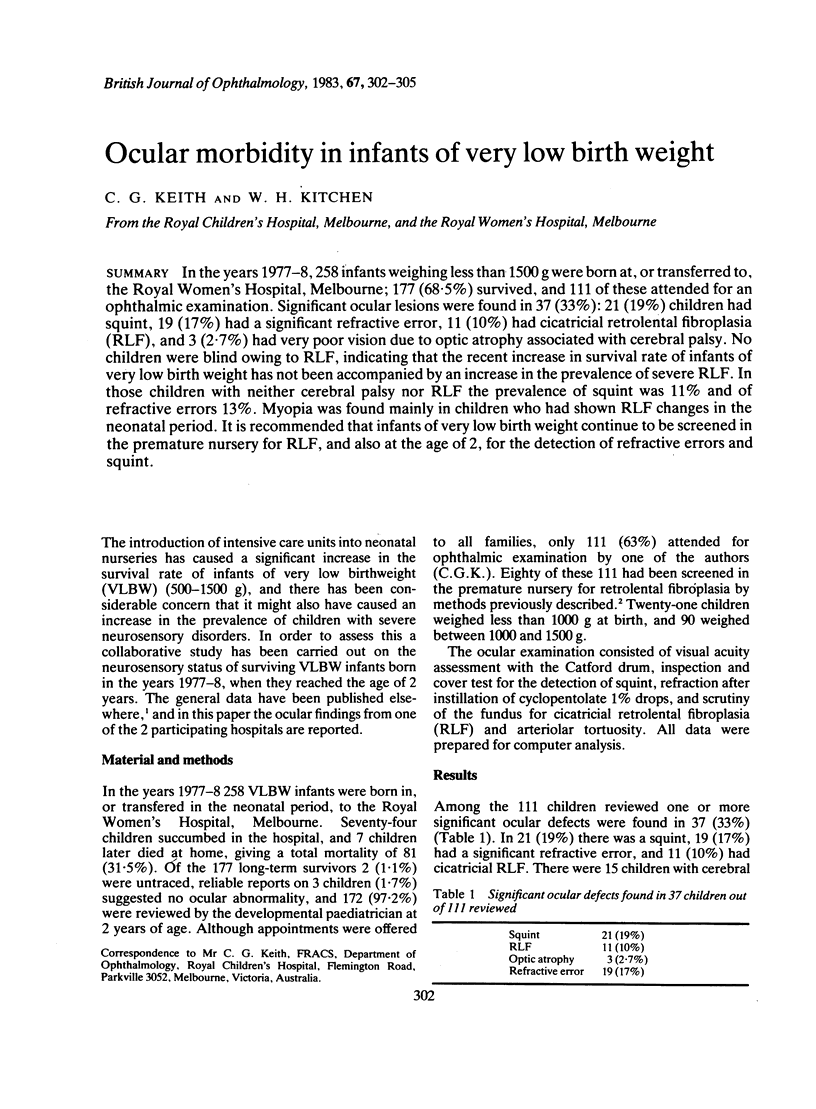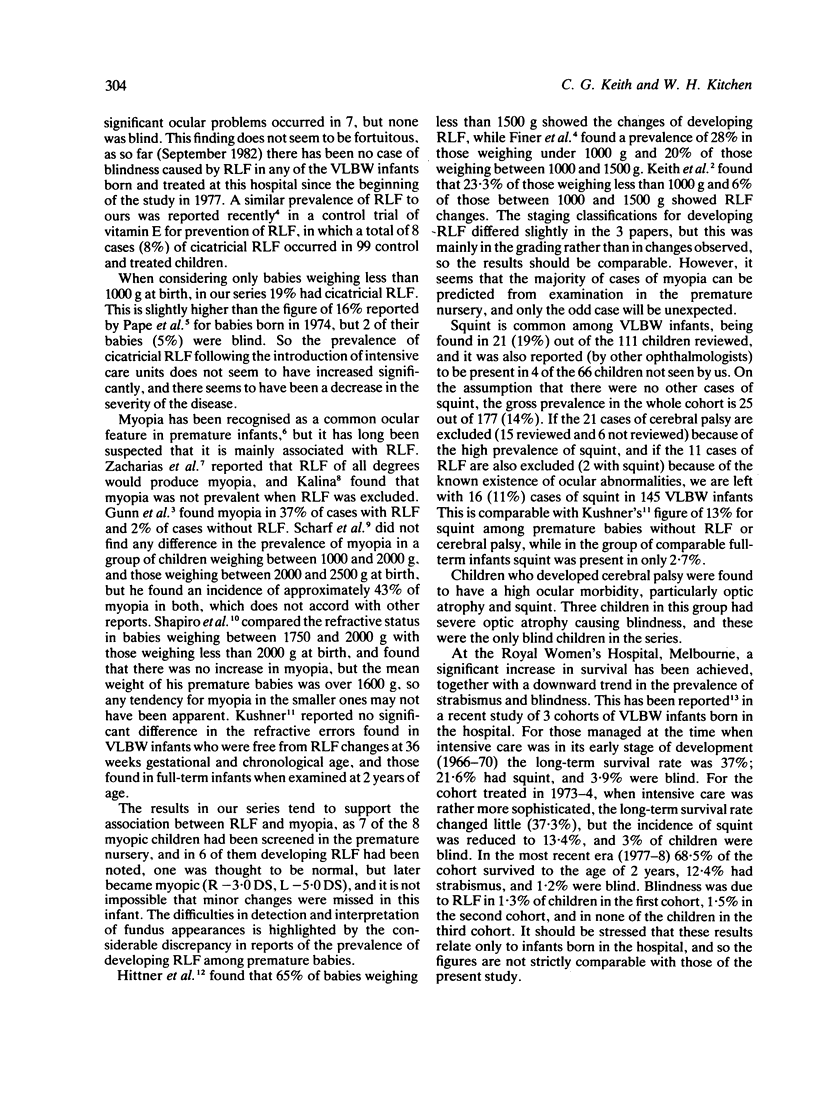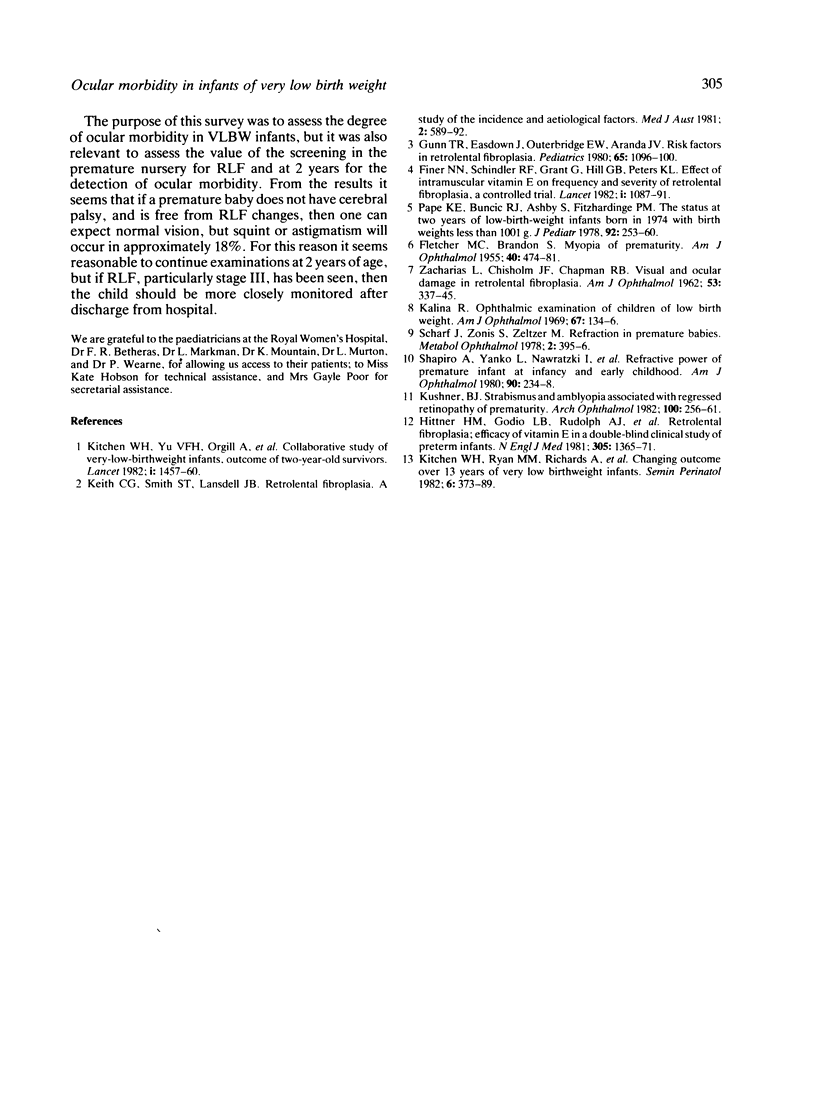Abstract
In the years 1977-8,258 infants weighing less than 1500 g were born at, or transferred to, the Royal Women's Hospital, Melbourne; 177 (68.5%) survived, and 111 of these attended for an ophthalmic examination. Significant ocular lesions were found in 37 (33%): 21 (19%) children had squint, 19 (17%) had a significant refractive error, 11 (10%) had cicatricial retrolental fibroplasia (RLF), and 3 (2.7%) had very poor vision due to optic atrophy associated with cerebral palsy. No children were blind owing to RLF, indicating that the recent increase in survival rate of infants of very low birth weight has not been accompanied by an increase in the prevalence of severe RLF. In those children with neither cerebral palsy nor RLF the prevalence of squint was 11% and of refractive errors 13%. Myopia was found mainly in children who had shown RLF changes in the neonatal period. It is recommended that infants of very low birth weight continue to be screened in the premature nursery for RLF, and also at the age of 2, for the detection of refractive errors and squint.
Full text
PDF



Selected References
These references are in PubMed. This may not be the complete list of references from this article.
- FLETCHER M. C., BRANDON S. Myopia of prematurity. Am J Ophthalmol. 1955 Oct;40(4):474–481. doi: 10.1016/0002-9394(55)90548-1. [DOI] [PubMed] [Google Scholar]
- Finer N. N., Schindler R. F., Grant G., Hill G. B., Peters K. Effect of intramuscular vitamin E on frequency and severity of retrolental fibroplasia. A controlled trial. Lancet. 1982 May 15;1(8281):1087–1091. doi: 10.1016/s0140-6736(82)92276-0. [DOI] [PubMed] [Google Scholar]
- Gunn T. R., Easdown J., Outerbridge E. W., Aranda J. V. Risk factors in retrolental fibroplasia. Pediatrics. 1980 Jun;65(6):1096–1100. [PubMed] [Google Scholar]
- Hittner H. M., Godio L. B., Rudolph A. J., Adams J. M., Garcia-Prats J. A., Friedman Z., Kautz J. A., Monaco W. A. Retrolental fibroplasia: efficacy of vitamin E in a double-blind clinical study of preterm infants. N Engl J Med. 1981 Dec 3;305(23):1365–1371. doi: 10.1056/NEJM198112033052301. [DOI] [PubMed] [Google Scholar]
- Kalina R. E. Ophthalmic examination of children of low birth weight. Am J Ophthalmol. 1969 Jan;67(1):134–136. doi: 10.1016/0002-9394(69)90018-x. [DOI] [PubMed] [Google Scholar]
- Keith C. G., Smith S. T., Lansdell B. J. Retrolental fibroplasia: a study of the incidence and aetiological factors, 1977-1979. Med J Aust. 1981 Nov 28;2(11):589–592. doi: 10.5694/j.1326-5377.1981.tb113008.x. [DOI] [PubMed] [Google Scholar]
- Kitchen W. H., Ryan M. M., Rickards A., Astbury J., Ford G., Lissenden J. V., Keith C. G., Keir E. H. Changing outcome over 13 years of very low birthweight infants. Semin Perinatol. 1982 Oct;6(4):373–389. [PubMed] [Google Scholar]
- Kitchen W. H., Yu V. Y., Orgill A., Ford G. W., Rickards A., Astbury J., Ryan M. M., Russo W., Lissenden J. V., Bajuk B. Collaborative study of very-low-birthweight infants: Outcome of two-year-old survivors. Lancet. 1982 Jun 26;1(8287):1457–1460. doi: 10.1016/s0140-6736(82)92464-3. [DOI] [PubMed] [Google Scholar]
- Kushner B. J. Strabismus and amblyopia associated with regressed retinopathy of prematurity. Arch Ophthalmol. 1982 Feb;100(2):256–261. doi: 10.1001/archopht.1982.01030030258004. [DOI] [PubMed] [Google Scholar]
- Pape K. E., Buncic R. J., Ashby S., Fitzhardinge P. M. The status at two years of low-birth-weight infants born in 1974 with birth weights of less than 1,001 gm. J Pediatr. 1978 Feb;92(2):253–260. doi: 10.1016/s0022-3476(78)80020-1. [DOI] [PubMed] [Google Scholar]
- Shapiro A., Yanko L., Nawratzki I., Merin S. Refractive power of premature children at infancy and early childhood. Am J Ophthalmol. 1980 Aug;90(2):234–238. doi: 10.1016/s0002-9394(14)74860-3. [DOI] [PubMed] [Google Scholar]
- ZACHARIAS L., CHISHOLM J. F., Jr, CHAPMAN R. B. Visual and ocular damage in retrolental fibroplasia. Am J Ophthalmol. 1962 Feb;53:337–345. doi: 10.1016/0002-9394(62)91184-4. [DOI] [PubMed] [Google Scholar]


